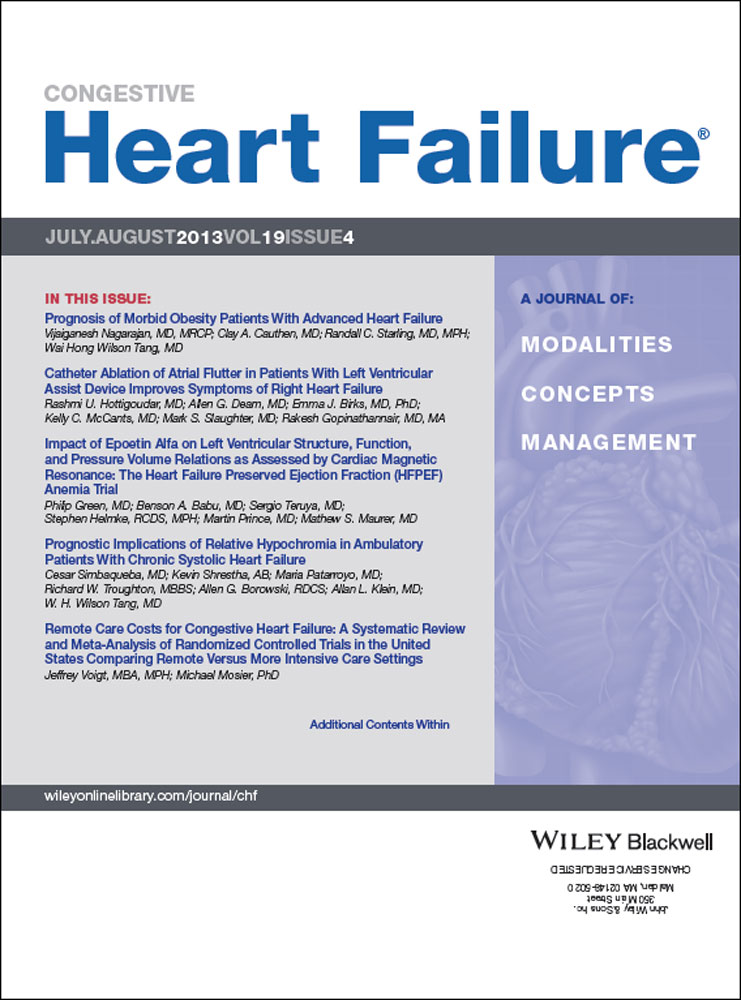Predictors of Isotonic Exercise in Patients With Heart Failure
Abstract.
Purpose. Study aims were to determine the predictors of isotonic resistance exercise performance in patients with advanced heart failure and to compare the pre-exercise values of patients who experienced a negative physiologic response to resistance exercise with those who had minimal or no response.
Methods. A correlational design was used. After pharmacologic left ventricular unloading therapy using a pulmonary artery catheter, 34 patients with advanced heart failure performed graduated isotonic weight-lifting exercises. Measurements were made of hemodynamics and rating of perceived exertion after each test.
Results. The following variables, measured at baseline, were significantly correlated with the amount of weight patients were able to lift: rating of perceived exertion (RPE; r=−0.42; p=0.014); diastolic blood pressure (DBP; r=0.49; p=0.03); systolic blood pressure (SBP; r=0.40; p=0.017); pulmonary capillary wedge pressure (PCWP; r=0.39; p=0.026); and right atrial pressure (RAP; r=0.35; p=0.041). Multiple regression analysis, using a stepwise procedure, showed that 47% of the variance in exercise performance was explained by DBP, RPE, and PCWP There were no significant differences in baseline hemodynamics, ejection fraction, or age between the group of patients who had a negative hemodynamic response at peak exercise and the group of patients who had minimal or no response.
Conclusions. Resting PCWP, DBP, and RPE can provide important information to help clinicians predict isotonic resistance exercise performance in patients with advanced heart failure. However, those patients who have a negative response to this type of exercise cannot be distinguished at baseline by clinical characteristics or age.—King ML, Dracup KA, Woo MA. Predictors of isotonic exercise in patients with heart failure. Med Sci Sports Exerc. 2001;33(7):1090–1095.
Comment. The incidence of congestive heart failure continues to increase. We know that these patients can benefit a great deal from exercise; however, which exercises are beneficial and how to best prescribe an exercise program for these patients remain less clear. There is a body of information that suggests that predictors of aerobic exercise performance, including systolic blood pressure, heart rate, and skeletal muscle factors, are not predictive of isotonic resistance exercise performance in heart failure patients. The benefits of this form of resistance exercise are prevention, or at least attenuation, of deconditioning, and it also has positive effects on genetic expression of proteins as well as on the release of nitric oxide from vascular endothelial cells. When patients successfully undertake a resistance exercise training program, there are significant increases in their muscle strength as well as overall endurance.
The authors of this paper designed a study to determine what factors predict the most effective exercise performance in patients with heart failure by use of a pulmonary artery catheter. Thirty-four patients with advanced heart failure performed a variety of isotonic weight lifting exercises in a graduated format. All patients had undergone pharmacologic left ventricular unloading therapy guided by pulmonary artery catheter hemodynamics. The data obtained were hemodynamic measurements and ratings of perceived exertion following each test.
The authors concluded that resting wedge pressure, DBP, and assessment of perceived exertion can provide helpful information for health care providers in deciding on what types and what level of exercise patients with advanced heart failure can perform. They also determined that patients who are not well suited for significant isotonic exercise cannot be distinguished by clinical characteristics or age alone.
For those of us who must contend with clinical congestive heart failure, it has long been recognized that these are very difficult patients to manage. Despite advances in our understanding of heart failure and our ability to treat it, our control of this disease is far from perfect. By using the information gleaned from this trial, as well as the robust amount of data from other exercise studies, clinicians should be able to more effectively optimize patients' quality of life. While exercise remains a very important part of the therapeutic regimen, the exact protocols recommended for patients must be individualized.




